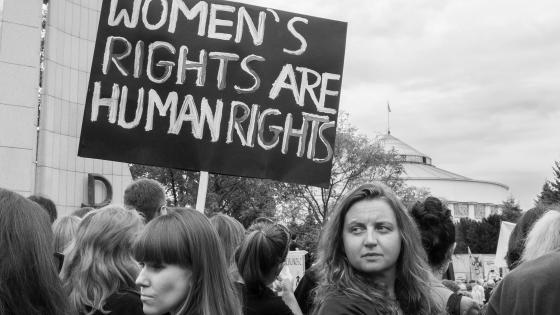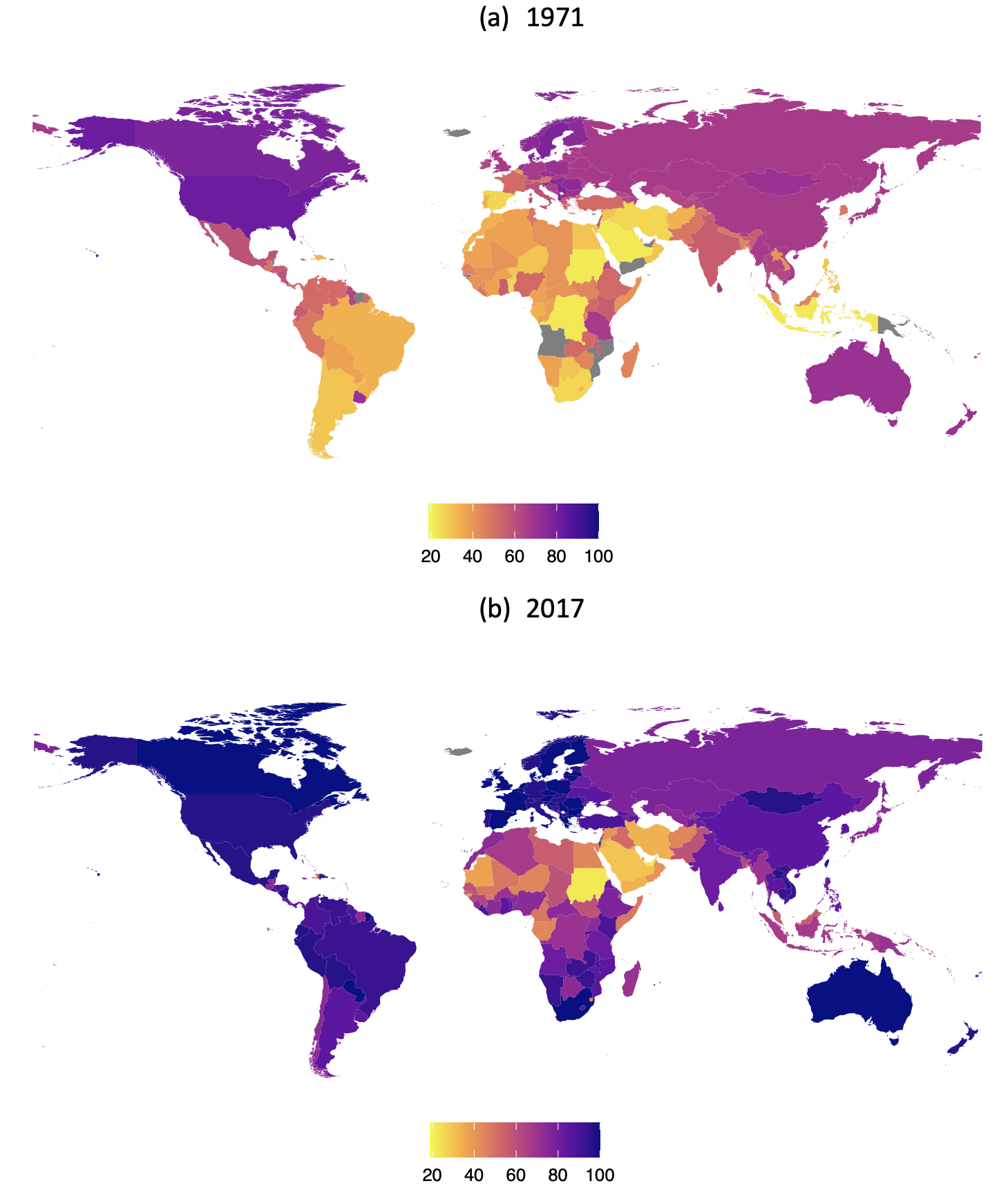In 1979, the UN Convention on the Elimination of All Forms of Discrimination against Women set an agenda for expanding women’s rights around the world. Shortly after, the International Bill of Rights for Women was instituted by the UN General Assembly in 1981 and has been ratified by 189 member states since.
Yet, the vision of equal rights for women is still not fully realised. In the year 2000, women could not obtain a passport as easily as men in a quarter of countries. In more than 30% of countries, women were not allowed to work the nightshift in the same way as men. Women also faced little protection against sexual harrassment and domestic violence in the majority of countries, and in a few countries they could not even vote. Figure 1 shows that even in 2017, women and men continued to be unequal by law in many countries.
Figure 1 Women’s rights across the world in 1971 and 2017
Note: The displayed index summarises the overall percentage of equality laws in place in a country that concern women’s economic, political, labour market, and body rights. The index ranges from 0 to 100, where 100 corresponds to legal equality between women and men.
Women’s rights – or the lack thereof – have consequences. For example, property rights shape women’s incentives to invest and innovate (Khan 1996), restrictive labour legislation depresses female employment (Zabalza and Tzannatos 1985), and access to contraception and abortion shapes labour supply and marriage decisions (Goldin and Katz 2002, Myers 2017).
Thus, it is important to understand why the legal standing of women varies so much across the world. Some countries have successfully implemented reforms over time, while others have not. In our research (Doepke et al. 2022), we explore these different experiences from the perspective of political-economy theories that spell out the incentives for individual voters and politicians to support women’s rights.
The expansion of women’s rights in the US
To explain the expansion of women’s rights, it is useful to take account of how reforms unfolded over time. The US provides a good example. Until the early 19th century, American women lost their legal identity upon getting married and accordingly could not sign a contract, own property, or initiate divorce. The legal position of American women began to improve in the mid-19th century when women started obtaining basic economic rights. For example, the state of New York passed the Married Women’s Property Act in 1848, and almost all states had given women the legal right to own property by 1900. Interestingly, the rights in this first stage of reform were granted to women at a time when only men could vote.
During the second stage of the expansion of women’s rights, women obtained political rights and, in particular, the right to vote in all elections in 1920. Laws regulating the legal equality of women in the labour market were passed much later during the 1960s, constituting the third stage in the expansion of women’s rights. The Equal Pay Act of 1963 and Title VII of the Civil Rights Acts of 1964 eliminated most labour market asymmetries between female and male employees. During the fourth stage, starting in the 1970s and still ongoing, women’s rights related to their own bodies have substantially improved. Specifically, laws were introduced that made marital rape, teenage marriage, domestic violence, and sexual harassment illegal and punishable by law.
Voting for women’s rights: Who benefits and who loses?
The expansion of legal rights is largely an outcome of people voting in favour of reforms. To understand voting patterns, one needs to start with people’s incentives for supporting women’s rights. We distinguish four channels that determine to what extent individuals benefit from the expansion of women’s rights.
First, women’s rights have an impact on the sharing of resources within families. When women have few rights, they have limited outside options in marital bargaining and thus are likely to receive a smaller share of resources. This bargaining power channel implies that women should generally be in favour of expansions in women’s rights, while men should be opposed.
Clearly, the bargaining power channel cannot explain why it was men who voted for the expansion of women’s economic rights at a time in US history when women did not yet have the right to vote. Hence, other motives must be at play. The parental altruism channel is about the impact of women’s rights that derives from people’s concern for their children. Assuming that fathers care about their children, they benefit from women’s rights through the beneficial effect on their daughters, and possibly more generally if women’s rights increase investments in children overall.
Expanding women’s rights also has the potential to increase total resources in the family – in particular, when women are incentivised to work – which, in turn, can benefit women and men alike. We call this the income channel. Finally, including women in policymaking can alter chosen policies such as the extent of redistribution through taxes and transfers and the provision of public goods. Thus, people whose political preferences align with those of women, regardless of their own gender, would benefit from expanding women’s rights. We refer to this motive as the public policy channel.
Which of these channels dominate for the majority of the voting population determines whether women’s rights are expanded or not. Since economic forces affect the relative strength of the channels, economic changes can affect the trade-off and thereby lead to reforms.
For example, in an agrarian society where education is of little importance, the bargaining power channel may dominate and prevent the expansion of rights for women. Doepke and Tertilt (2009) show that women’s property rights in the US were extended precisely when returns to education increased and the benefits from women’s rights through the parental altruism channel grew relative to potential losses stemming from the bargaining power channel.
Similarly, Geddes and Lueck (2002) provide evidence that links expansions of women’s rights to a rising return to female market work, which supports the income channel. Bertocchi (2011) argues that women obtained the right to vote when economic forces lowered the gender wage gap and policy preferences of men and women became more aligned, i.e. when the public policy channel started to dominate.
Women’s rights around the world today
Motivated by the staged expansion of women’s rights in the US, we construct indices of women’s rights that capture the four legal domains: economic, political, labour, and body rights. Figure 2 plots how the cross-country average of these four indices has changed over the last 50 years.
We find that reforms around the world have followed a similar pattern as in the US. Economic and political rights were already widespread in the 1970s, whereas labour and body rights were much less developed. Since then, labour rights have expanded steadily around the world, whereas the expansion of body rights did not accelerate until the mid-1990s.
Figure 2 Worldwide increase in four women’s rights indices
To explore the drivers of these expansions in women’s rights, we combine data on legal rights with information on economic variables over the past 50 years. Specifically, we use GDP per capita as a measure of the overall level of development, female labour force participation as a proxy of the income channel for the expansion of women’s rights, and the total fertility rate as a proxy of the parental altruism channel (because fertility decline is linked to a changing role of the family and rising investment in human capital).
Figure 3 plots an overall measure of women’s rights from the World Bank against the three economic drivers. Female labour force participation is positively associated with women’s rights, consistent with the income channel, and the total fertility rate is negatively associated with women’s rights, consistent with a role for the parental altruism channel. More generally, women’s rights are positively associated with economic development as captured by per-capita GDP.
The same results are confirmed using a more formal regression analysis that considers all variables jointly and also controls for the effects of religion and other cultural and time-dependent factors. In each case, the economic channels account for a substantial fraction of the variation in women’s rights. Nevertheless, non-economic factors also matter. For example, we find that religion, in particular whether the majority of a country is Muslim, can dampen the positive effect of economic drivers on women’s rights.
Figure 3 Women's rights and total fertility, female labour force participation, and GDP per capita in 2000
Policy implications and outlook
The agenda for women’s rights set by the 1979 UN Convention was not as successful as many had hoped. Women have yet to reach full legal equality around the world in all of the four legal domains captured by our rights indices, and especially in poor countries large gaps remain. Our analysis suggests that political activism alone might not be enough to trigger further reforms. Reforms happen when a politically decisive coalition benefits from expanding women’s rights, and economic conditions can dampen these benefits. For example, when people live on subsistence farming and education is considered relatively unimportant, men might perceive only limited benefits from extending formal rights to women. Similarly, when few married women are working, married men and women may oppose equal labour market rights out of fear of increased competition from (single) women in the labour market. Thus, an important step in achieving full legal gender equality is fostering economic development, leading to conditions under which the costs of limiting women’s rights becomes too high to ignore.
References
Bertocchi, G (2011), “The Enfranchisement of Women and the Welfare State”, European Economic Review 55(4): 535 – 553.
Doepke, M and M Tertilt (2009), “Women’s Liberation: What’s in It for Men?”,
Quarterly Journal of Economics 124(4): 1541–1591.
Geddes, R and D Lueck (2002), “The Gains From Self-Ownership and the Expansion of Women’s Rights”, American Economic Review 92(4): 1079–1092.
Goldin, C and L F Katz (2002), “The Power of the Pill: Oral Contraceptives and Women’s Career and Marriage Decisions”, Journal of Political Economy 110(4): 730–770.
Khan, B Z (1996), “Married Women’s Property Laws and Female Commercial Activity: Evidence from United States Patent Records, 1790-1895”, The Journal of Economic History 56(2): 356–388.
Myers, C K (2017), “The Power of Abortion Policy: Reexamining the Effects of Young Women’s Access to Reproductive Control”, Journal of Political Economy 125(6): 2178–2224.
Doepke, M, A Hannusch, L Montenbruck and M Tertilt (2022), “The Economics of Women's Rights”, Journal of the European Economic Association (forthcoming).
Zabalza, A and Z Tzannatos (1985), “The Effect of Britain’s Anti-Discriminatory Legislation on Relative Pay and Employment”, The Economic Journal 95(379): 679–699.









